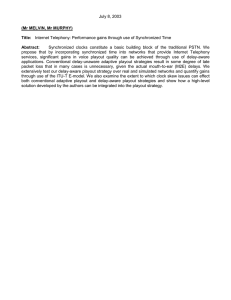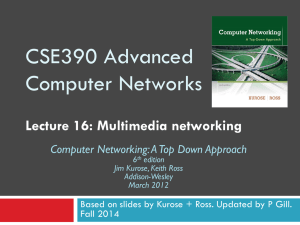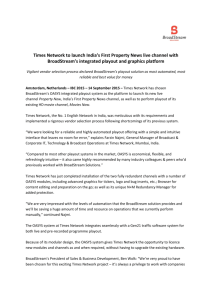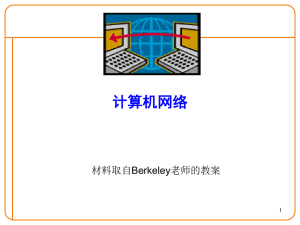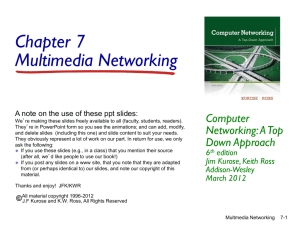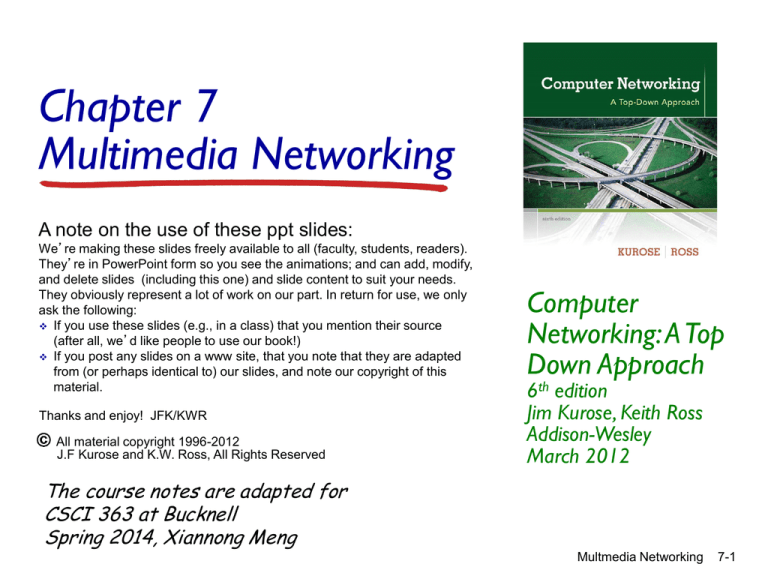
Chapter 7
Multimedia Networking
A note on the use of these ppt slides:
We’re making these slides freely available to all (faculty, students, readers).
They’re in PowerPoint form so you see the animations; and can add, modify,
and delete slides (including this one) and slide content to suit your needs.
They obviously represent a lot of work on our part. In return for use, we only
ask the following:
If you use these slides (e.g., in a class) that you mention their source
(after all, we’d like people to use our book!)
If you post any slides on a www site, that you note that they are adapted
from (or perhaps identical to) our slides, and note our copyright of this
material.
Thanks and enjoy! JFK/KWR
All material copyright 1996-2012
J.F Kurose and K.W. Ross, All Rights Reserved
Computer
Networking: A Top
Down Approach
6th edition
Jim Kurose, Keith Ross
Addison-Wesley
March 2012
The course notes are adapted for
CSCI 363 at Bucknell
Spring 2014, Xiannong Meng
Multmedia Networking
7-1
Content distribution networks
challenge: how to stream content (selected from
millions of videos) to hundreds of thousands of
simultaneous users?
option 1: single, large “mega-server”
single point of failure
point of network congestion
long path to distant clients
multiple copies of video sent over outgoing link
….quite simply: this solution doesn’t scale
Multmedia Networking
7-2
Content distribution networks
challenge: how to stream content (selected from
millions of videos) to hundreds of thousands of
simultaneous users?
option 2: store/serve multiple copies of videos at
multiple geographically distributed sites (CDN)
enter deep: push CDN servers deep into many access
networks
• close to users
• used by Akamai, 1700 locations
bring home: smaller number (10’s) of larger clusters in
POPs near (but not within) access networks
• used by Limelight
Multmedia Networking
7-3
CDN: “simple” content access scenario
Bob (client) requests video http://netcinema.com/6Y7B23V
video stored in CDN at http://KingCDN.com/NetC6y&B23V
1. Bob gets URL for for video
http://netcinema.com/6Y7B23V
2. resolve http://netcinema.com/6Y7B23V
from netcinema.com
2 via Bob’s local DNS
web page
1
6. request video from 5
4&5. Resolve
KINGCDN server,
http://KingCDN.com/NetC6y&B23
streamed via HTTP
via KingCDN’s authoritative DNS,
3.
netcinema’s
DNS
returns
URL
netcinema.com
4 which returns IP address of KIingCDN
http://KingCDN.com/NetC6y&B23V
server with video
3
netcinema’s
authorative DNS
KingCDN.com
KingCDN
authoritative DNS
Multmedia Networking
7-4
CDN cluster selection strategy
challenge: how does CDN DNS select “good”
CDN node to stream to client
pick CDN node geographically closest to client
pick CDN node with shortest delay (or min # hops) to
client (CDN nodes periodically ping access ISPs,
reporting results to CDN DNS)
IP anycast
alternative: let client decide - give client a list of
several CDN servers
client pings servers, picks “best”
Netflix approach
Multmedia Networking
7-5
Case study: Netflix
30% downstream US traffic in 2011
owns very little infrastructure, uses 3rd party
services:
own registration, payment servers
Amazon (3rd party) cloud services:
• Netflix uploads studio master to Amazon cloud
• create multiple version of movie (different
encodings) in cloud
• upload versions from cloud to CDNs
• Cloud hosts Netflix web pages for user browsing
three 3rd party CDNs host/stream Netflix
content: Akamai, Limelight, Level-3
Multmedia Networking
7-6
Case study: Netflix
Amazon cloud
Netflix registration,
accounting servers
2. Bob browses
Netflix video 2
upload copies of
multiple versions of
video to CDNs
3. Manifest file
returned for
requested video
Akamai CDN
Limelight CDN
3
1
1. Bob manages
Netflix account
4. DASH
streaming
Level-3 CDN
Multmedia Networking
7-7
Multimedia networking: outline
7.1 multimedia networking applications
7.2 streaming stored video
7.3 voice-over-IP
7.4 protocols for real-time conversational
applications
7.5 network support for multimedia
Multmedia Networking
7-8
Voice-over-IP (VoIP)
VoIP end-end-delay requirement: needed to maintain
“conversational” aspect
higher delays noticeable, impair interactivity
< 150 msec: good
> 400 msec bad
includes application-level (packetization,playout),
network delays
session initialization: how does callee advertise IP
address, port number, encoding algorithms?
value-added services: call forwarding, screening,
recording
emergency services: 911
Multmedia Networking
7-9
VoIP characteristics
speaker’s audio: alternating talk spurts, silent
periods.
64 kbps during talk spurt
pkts generated only during talk spurts
20 msec chunks at 8 Kbytes/sec: 160 bytes of data
application-layer header added to each chunk
chunk+header encapsulated into UDP or TCP
segment
application sends segment into socket every 20
msec during talkspurt
Multmedia Networking 7-10
VoIP: packet loss, delay
network loss: IP datagram lost due to network
congestion (router buffer overflow)
delay loss: IP datagram arrives too late for playout
at receiver
delays: processing, queueing in network; end-system
(sender, receiver) delays
typical maximum tolerable delay: 400 ms
loss tolerance: depending on voice encoding, loss
concealment, packet loss rates between 1% and
10% can be tolerated
Multmedia Networking 7-11
Delay jitter
variable
network
delay
(jitter)
client
reception
constant bit
rate playout
at client
buffered
data
constant bit
rate
transmission
time
client playout
delay
end-to-end delays of two consecutive packets:
difference can be more or less than 20 msec
(transmission time difference)
Multmedia Networking 7-12
VoIP: fixed playout delay
receiver attempts to playout each chunk exactly q
msecs after chunk was generated.
chunk has time stamp t: play out chunk at t+q
chunk arrives after t+q: data arrives too late
for playout: data “lost”
tradeoff in choosing q:
large q: less packet loss
small q: better interactive experience
Multmedia Networking 7-13
VoIP: fixed playout delay
sender generates packets every 20 msec during talk spurt.
first packet received at time r
first playout schedule: begins at p
second playout schedule: begins at p’
packets
loss
packets
generated
packets
received
playout schedule
p' - r
playout schedule
p-r
time
r
p
p'
Multmedia Networking 5-14
Adaptive playout delay (1)
goal: low playout delay, low late loss rate
approach: adaptive playout delay adjustment:
estimate network delay, adjust playout delay at
beginning of each talk spurt
silent periods compressed and elongated
chunks still played out every 20 msec during talk spurt
adaptively estimate packet delay: (EWMA exponentially weighted moving average, recall TCP RTT
estimate):
di = (1-a)di-1 + a (ri – ti)
delay estimate
after ith packet
small constant,
e.g. 0.1
time received - time sent
(timestamp)
measured delay of ith packet
Multmedia Networking 7-15
Adaptive playout delay (2)
also useful to estimate average deviation of delay, vi :
vi = (1-b)vi-1 + b |ri – ti – di|
estimates di, vi calculated for every received
packet, but used only at start of talk spurt
for first packet in talk spurt, playout time is:
playout-timei = ti + di + Kvi
remaining packets in talkspurt are played out
periodically
Multmedia Networking 5-16
Adaptive playout delay (3)
Q: How does receiver determine whether packet is
first in a talkspurt?
if no loss, receiver looks at successive timestamps
difference of successive stamps > 20 msec -->talk spurt
begins.
with loss possible, receiver must look at both time
stamps and sequence numbers
difference of successive stamps > 20 msec and sequence
numbers without gaps --> talk spurt begins.
Multmedia Networking 7-17
VoiP: recovery from packet loss (1)
Challenge: recover from packet loss given small
tolerable delay between original transmission and
playout
each ACK/NAK takes ~ one RTT
alternative: Forward Error Correction (FEC)
send enough bits to allow recovery without
retransmission (recall two-dimensional parity in Ch. 5)
simple FEC
for every group of n chunks, create redundant chunk by
exclusive OR-ing n original chunks
send n+1 chunks, increasing bandwidth by factor 1/n
can reconstruct original n chunks if at most one lost chunk
from n+1 chunks, with playout delay
Multmedia Networking 7-18
Simple FEC example
Data: 1001
1101
1101
1000
0111
-----------cksm: 0110
If 2nd packet lost
Data: 1001
1101
1101
1000
0111
-----------cksm: 0110
The lost packet can be re-constructed through checksum
1001 xor 1101 xor 1000 xor 0111 xor 0110 = 1101
Multmedia Networking 7-19
VoiP: recovery from packet loss (2)
another FEC scheme:
lower
quality stream”
send lower resolution
audio stream as
redundant information
e.g., nominal
stream PCM at 64 kbps
and redundant stream
GSM at 13 kbps
non-consecutive loss: receiver can conceal loss
generalization: can also append (n-1)st and (n-2)nd low-bit rate
chunk
“piggyback
Multmedia Networking 7-20
VoiP: recovery from packet loss (3)
interleaving to conceal loss:
audio chunks divided into
smaller units, e.g., four 5
msec units per 20 msec
audio chunk
packet contains small units
from different chunks
if packet lost, still have most
of every original chunk
no redundancy overhead,
but increases playout delay
Multmedia Networking 7-21
Voice-over-IP: Skype
proprietary applicationlayer protocol (inferred
via reverse engineering)
encrypted msgs
P2P components:
clients: skype peers
connect directly to
each other for VoIP call
Skype clients (SC)
Skype
login server
supernode (SN)
supernode
overlay
network
super nodes (SN):
skype peers with
special functions
overlay network: among
SNs to locate SCs
login server
Application Layer 2-22
P2P voice-over-IP: skype
skype client operation:
1. joins skype network by
contacting SN (IP address
cached) using TCP
2. logs-in (usename,
password) to centralized
skype login server
3. obtains IP address for
callee from SN, SN
overlay
or client buddy list
4. initiate call directly to
callee
Skype
login server
Application Layer 2-23
Skype: peers as relays
problem: both Alice, Bob
are behind “NATs”
NAT prevents outside peer
from initiating connection to
insider peer
inside peer can initiate
connection to outside
relay solution:Alice, Bob maintain
open connection
to their SNs
Alice signals her SN to connect
to Bob
Alice’s SN connects to Bob’s
SN
Bob’s SN connects to Bob over
open connection Bob initially
initiated to his SN
Application Layer 2-24

